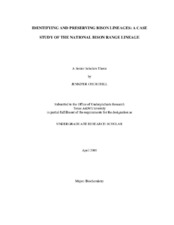| dc.description.abstract | While over 500,000 bison exist today, the long-term conservation of this species is not assured because only five percent of all bison are maintained in conservation herds and genetic evidence of domestic cattle introgression has been detected in nearly all herds evaluated to date. Prior to the introduction of domestic cattle DNA into the National Bison Range (Montana, USA) herd in the 1980s, historical records indicate that four separate herds were formed in Alaska (USA) using bison from the National Bison Range lineage. Bison from these Alaskan herds were examined for the presence of domestic cattle introgression. In addition, 46 nuclear microsatellite markers and mitochondrial sequence data were used to analyze the patterns of genetic diversity and evaluate the relationship of the Alaskan and National Bison Range herds. Neither nuclear nor mitochondrial domestic cattle introgression was detected in the NBR-Alaska bison examined in this study. The bison mitochondrial haplotypes found in the NBR-Alaska herds are consistent with previously identified NBR bison haplotypes. In addition, all of the alleles from the diversity marker panel except for three have been identified in the NBR herd. The identification of sources of bison germplasm without evidence of domestic cattle DNA introgression is crucial for the conservation of the National Bison Range lineage and preservation of the bison species. | en |


